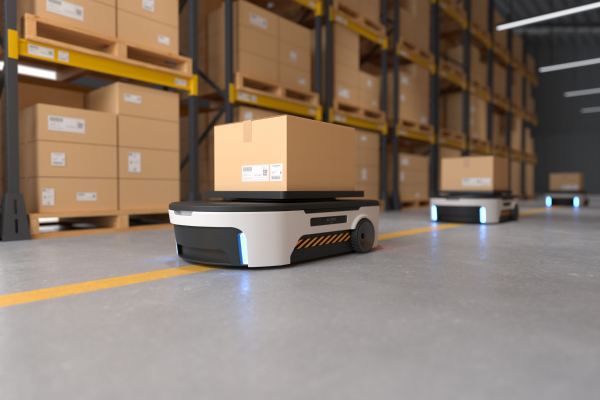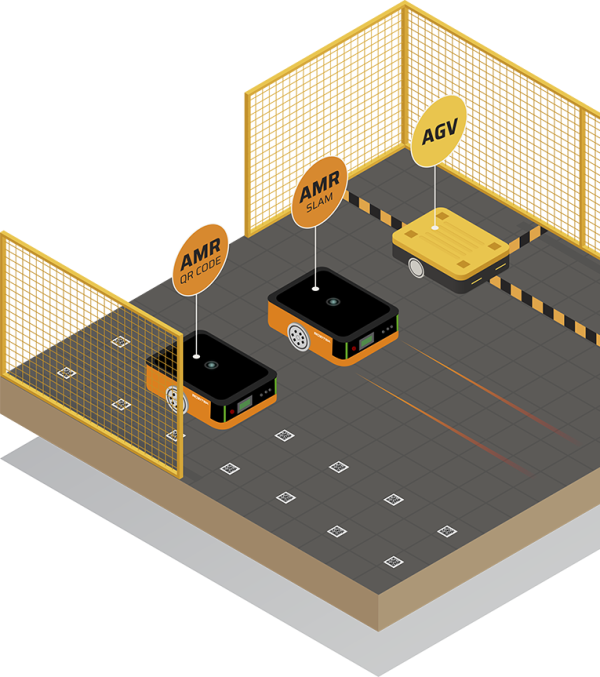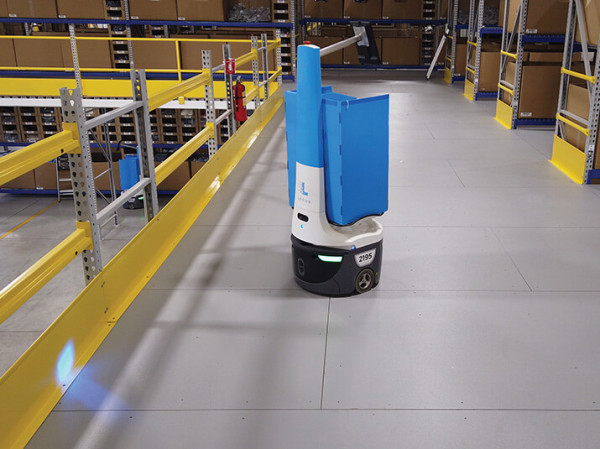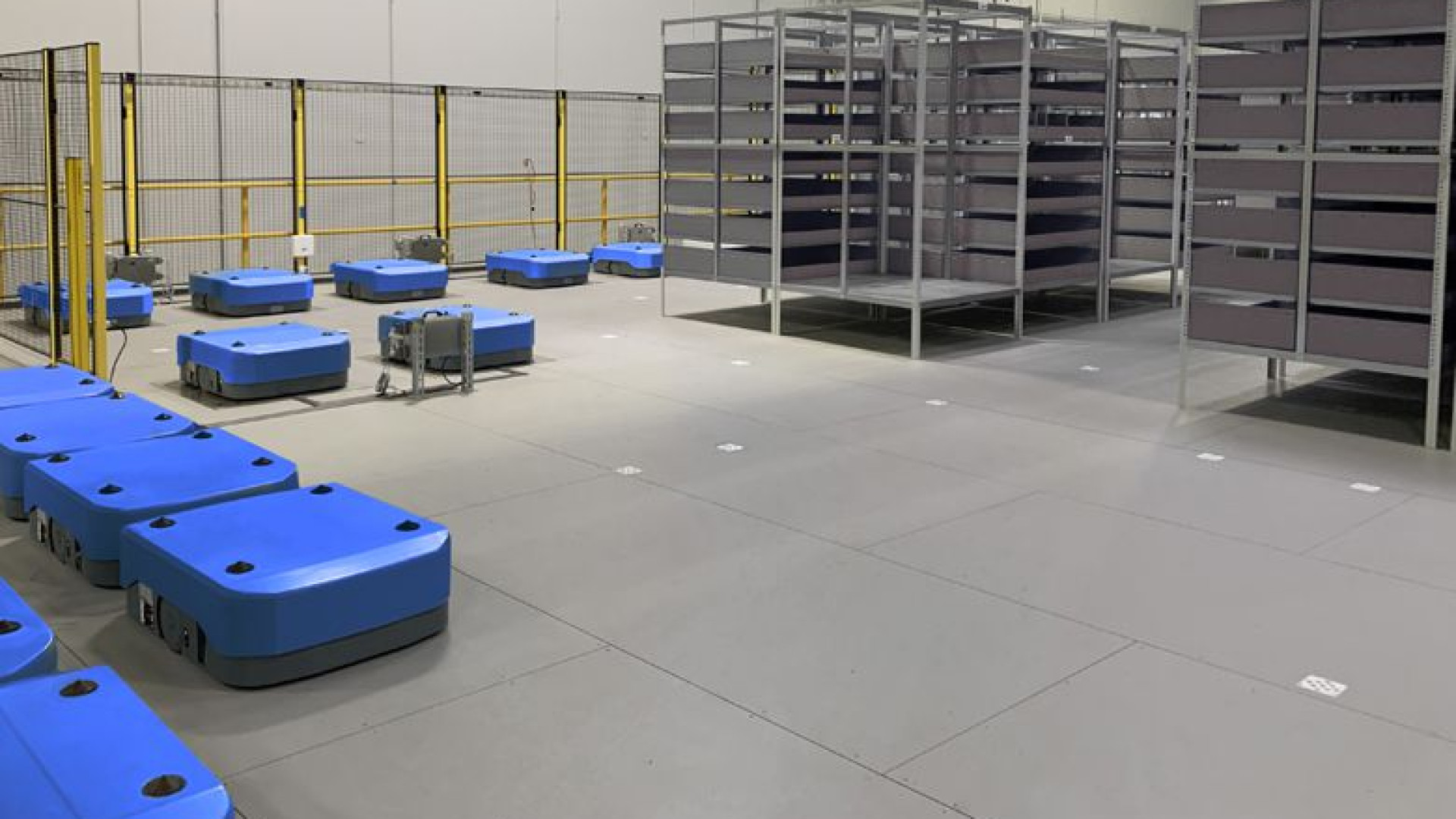AMRs, or Autonomous Mobile Robots, have become a coveted asset for industries in recent years, due to their ability to navigate independently through environments using advanced sensor technology and intelligent software.
These robots are not confined to predefined paths like AGVs but can adapt to real-time changes, making them highly suitable for dynamic environments such as warehouses, healthcare and manufacturing.
Learn the basics about AMR robots and how they can be applied to automated storage and retrieval systems (ASRS) in your mezzanine warehouse.

What are Autonomous Mobile Robots (AMRs)?
AMRs are robots designed to move and operate independently within an environment. Unlike traditional Automated Guided Vehicles (AGVs), which require fixed paths to function, AMRs utilise sophisticated sensors and algorithms to navigate dynamically.
This allows the AMR to adjust its routes based on real-time data, making a fleet of AMRs (often referred to as an AMR system) ideal for a variety of tasks, from transporting materials in warehouses to assisting in healthcare facilities.
Key components of AMRs
AMRs consist of several key components:
-
Mobility platform
-
Sensors
-
Control systems
-
Power supply
The mobility platform, usually wheeled, enables the robot to move. Sensors such as LiDAR, cameras, and ultrasonic sensors provide environmental mapping. Control systems process this sensor data to make navigation decisions. The power supply, typically a rechargeable battery, powers the robot.
How do AMRs work?
Do not be deceived by their simple exterior—it takes many moving parts for AMRs to get the job done. Some of these components include:
Sensor Technology
The core of AMR robots lies in their sensors, which allow them to perceive their environment. Key types of sensors include LiDAR (Light Detection and Ranging), which creates detailed 3D maps for navigation, and cameras, which capture visual data for object identification and obstacle detection. Ultrasonic sensors use sound waves to detect nearby objects, while infrared sensors detect objects and measure distances using infrared light.
Navigation Systems
AMRs use various navigation systems to operate autonomously. SLAM (Simultaneous Localisation and Mapping) builds a map of the environment while tracking the robot’s location. Waypoint navigation uses predefined points in the environment to guide the robot. Path planning algorithms determine the most efficient route considering obstacles and destinations.
Control Systems
Control systems are crucial for managing AMR movement. They interpret sensor data and adjust motor commands to maintain the desired path. Common control algorithms include PID (Proportional-Integral-Derivative) Controllers, which adjust motor commands based on error calculations, and Model Predictive Control (MPC), which uses mathematical models to predict and optimise robot behaviour.

Common Applications of AMR Warehouse Automation
Below are some of the most common applications of AMR technology across different sectors, showcasing how these robots are redefining the way we approach tasks and manage processes:
Warehousing and logistics
AMR robots re-write the script of warehousing by performing tasks such as material handling, order picking, and inventory management. They can transport goods within the warehouse, select items from shelves, and prepare them for shipment. AMRs also navigate the warehouse, scanning barcodes or using computer vision to identify items and update inventory records.
Healthcare
In healthcare, AMRs improve efficiency and patient care by transporting medical supplies, delivering medications and equipment, and assisting in patient care. They can monitor patients' vital signs and alert healthcare staff if abnormalities are detected. AMRs can also assist in disinfection and cleaning, navigating hospital rooms and common areas to kill bacteria and viruses.
Manufacturing
In manufacturing, AMRs enhance operations by moving raw materials and finished products, assisting in product assembly with robotic arms, and inspecting products for defects. They streamline operations, reduce the need for manual labour and increase overall efficiency. Quality control and inspection are other important applications of AMRs in manufacturing.
Advantages of AMR robots
AMR robots offer several advantages over traditional automation solutions.
They are highly flexible, and able to adapt to changes in the environment without fixed paths. This adaptability makes them suitable for various applications and industries. AMRs also improve efficiency by automating repetitive tasks, reducing labour costs and increasing speed.
In recent years, technological leaps have been made in relation to the advanced sensors and control systems available on modern AMR systems, ensuring high precision, while reducing errors and defects.
Safety is another key advantage, as AMRs can operate alongside humans with collision avoidance features.
Additionally, their use of energy-efficient components and optimised paths contribute to sustainability.

Challenges of adopting AMR - automated robots
Of course, there are two sides of the same coin. AMR robots can also present challenges. Integration with existing systems can require significant modifications, and developing and maintaining the software and algorithms that control AMRs requires specialised expertise. Operational changes, such as training employees to work alongside robots, are necessary. The initial financial investment can be substantial, which may be a barrier for smaller businesses. Ensuring regulatory compliance and meeting safety standards is also crucial.
Integrating AMRs with AutoStore Grid ASRS
Imagine combining the power of AMRs with the AutoStore Grid automated storage and retrieval system (ASRS) in your industrial mezzanine setup. These robots can move totes and racks between different mezzanine levels, efficiently handling bins and navigating the vertical space with ease.
A combined AutoStore Grid + AMR setup offers far more flex and adaptability than traditional AGVs and conveyors, especially in multi-level storage environments - squeezing every last inch out of your vertical space and overall storage capacity.
Partner with Unistor to future-proof your warehouse
Without a shadow of doubt, AMR robots are transforming industries by providing flexible, efficient and accurate automation solutions. Their ability to navigate and adapt to dynamic environments makes them invaluable tools in warehouses, healthcare and manufacturing.
The versatility, efficiency, and benefits of an AMR solution is evident - such is the impact of automated solutions such as AMR that there are real-world competitive advantages that come with such a setup. Yet there are also distinct challenges brought to the fold by this technological advancement. Harnessing the potential of AMR, while simultaneously addressing their limitations and coming up with , will influence the future of work and technology in our increasingly automated world.
At Unistor, we embrace the future of warehousing by working with select system integration and automation partners - collaborating to deliver first-class AMR solutions to our customers.
With over thirty years of industry experience, we can help your business integrate AMRs and other automated solutions to empower your warehouse to exceed its targets and drive operational efficiencies. Whether it is through coordinating the implementation of ASRS advanced picking by one of our integration partners, or installing cutting-edge warehouse mezzanine systems ourselves, we are committed to tailoring a strategy that fits your unique business needs and objectives.
Ready to take your warehouse to new heights? Talk to the experts at Unistor about how automation can help take your operation to new heights.



